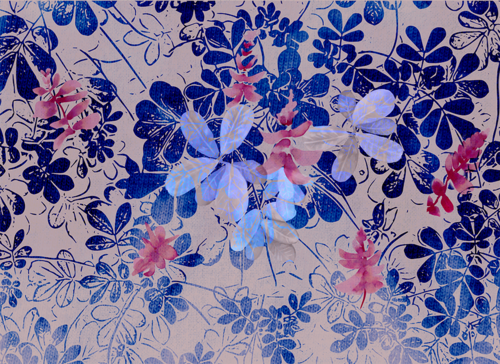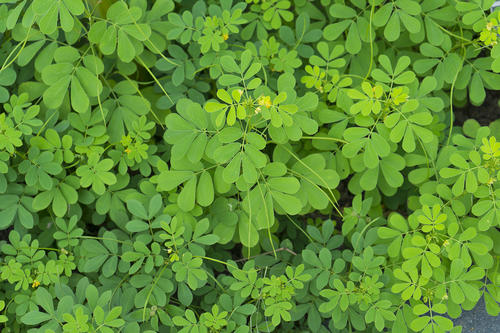 Image credit: Rebecca Rippon.
Image credit: Rebecca Rippon.
Natural pigments are naturally occurring substances used to impart color and come from three sources: plants, animals, and minerals. Cave paintings dating back 40,000 years contain paints made from earth minerals and charred bone. The oldest found paint mixture was made of ochre--an iron rich mineral--in the Blombos Cave in South Africa, and it dates back 100,000 years. The lack of paintings to go along with paints this old suggest they were used for painting bodies and dyeing fabric. Pigments for artists’ materials came only from these natural sources from prehistory through to the Renaissance and Baroque periods, until the first synthetic colors were created in 1704. Though synthetic colors had their advantages, they did not eliminate the use of natural pigments in art materials. Indigenous cultures across the globe have cultivated plant dyeing methods which remain an important part of tradition. Plant pigments are arguably the most accessible pigments to extract and process, and their attainability is a big reason they remain popular with artists today.
One of the most well known plant pigments comes from the indigo plant, which is really a family of plants with a wide variety of species spread all over the world. In all cases it is prized for the vivid and lasting blue hue it produces. Its ubiquity means it has played a role across many cultures. Indigo dyeing in Japan, for example, known there as ai-zome started around the 10th century. Early use was on clothing for the wealthy and samurai class. But indigo dyeing exploded in popularity during the Edo period (1600-1868), when Japanese commoners were restricted by law to wearing clothing made from only cotton or hemp. Indigo dyeing could produce dozens of shades of blue, giving people choices in their everyday dress. At that time, everything dyed indigo blue was all the rage in Japan, from clothing to objects. Indigo garments continued to be associated with the samurai class, who wore them under their armor. Due to Japanese indigo’s antibacterial qualities, these garments offered protection from infection from cuts and scrapes.
 Indigofera tinctoria plant, also called “True Indigo.”
Indigofera tinctoria plant, also called “True Indigo.”
It’s truly incredible that indigo dyeing was discovered in the first place. The plant’s leaves are dark green and offer no hint of the blue color it can produce until the leaves undergo a long, careful fermentation process. The blue only becomes evident when a dyed piece is exposed to the air, turning first from yellow to green, then to a deep blue. All of this requires a delicate balance, and a skilled hand to ensure success. Knowledge of this complex process has been traditionally passed down through generations. That tradition has been waning since the invention of synthetic indigo in 1882. Most indigo dyeing today is done with synthetic indigo. Its advent has nearly eradicated natural dyeing practices. However, since synthetic indigo is derived from petroleum (like most synthesized chemicals and dyes), its sustainability has come into question in recent years, and there is renewed interest in natural indigo dyeing.
Most other plants don’t require such an arduous process to extract their color. More conspicuous sources of pigments like flowers, vegetables, and berries have an equally far reaching history as color in artist materials. Creating dyes from these is often as straightforward as steeping petals, roots, and leaves in hot water and using the resulting liquid as a dye or like a watercolor paint. Yellow is common, and some favored sources for producing yellow include marigolds, safflower, and paprika. Orange hues can come from coreopsis flower or carrots. Beets make for a deep red, and avocado pits and skins make a pink dye. Spinach, mint, or artichokes impart green shades, though a lasting green is notoriously difficult to achieve. Purples come from red cabbage, black beans, and the seeds of the Hopi sunflower. Some plants, like the coreopsis and red cabbage, are natural pH indicators. These dyes will change color if a base or acid is added, such as baking soda or lemon juice. Some artists skip the extraction process and instead hammer or press flowers directly onto fabric or paper, leaving color deposits as well as an approximate image of the flower behind.
Despite the wide range of materials and convenience offered by art suppliers today, artists and artisans are still drawn to using color from plant pigments. Information abounds on how to make and apply plant dyes for transforming paper, textiles, and wood. For many, using them is a desire to connect their work to nature or cultural tradition. Others may find their own artist’s curiosity leading them to discover new approaches, and as results can be unpredictable, learn to relinquish some control of the outcome. For others, readily available plants provide materials they cannot afford to buy. There is also plenty of appeal in using processes and materials which do not harm the environment. And many prize the rich earth tones resulting from using plant pigments. For most, the reasons are likely to overlap. Once considered the “old” way of doing things, plant pigments have new life in the collective imagination.
Further exploration:
- Celebration (Waterworks) - Part of a series by Robert Rauschenberg in which he used vegetable dye in an effort to cease using materials harmful to his health and the environment.
- Emily Donovan - An artist who makes abstract and figurative paintings on paper using handmade plant dyes.
- Ruby Jagrut - An artist who paints “the state of the cosmos” on canvas with natural dyes. She teaches the art of creating natural dyes in workshops she conducts all over the globe.
- Kazumi Tanaka - An artist who creates watercolor paints from flowers, and paints the natural world.
- Nicole Stjernswärd - An artist who invented a system called Kaiku for turning plant waste into powdered pigments for use in paint, inks and dyes.
- Asian Textile Studies: Indigo - A comprehensive history and methodology of indigo dyeing.
- Chroma Botanica - A project by Ellie Irons and Linda Stillman using plant pigments from New York's public parks.










Comments (1)